Everyone praises Mercedes-Benz for its luxury cars and its incredible automotive history. The German car company not only invented the automobile but also honored this legacy by being among the first to adopt electromobility. Its EV lineup is among the most comprehensive among legacy carmakers, putting Mercedes-Benz at the forefront of this trend.
The first modern EV Mercedes-Benz produced was also a van
Mercedes-Benz focused its electrification efforts on its vans, considering that the last-mile delivery services could benefit the most from going electric. The electric vans have been continuously improved, and in 2010, they were mature enough that Mercedes launched the Vito E-Cell as the first mass-produced electric vehicle. It wasn’t sold but leased to select European fleet operators on a four-year contract. All vans were to be returned to Mercedes-Benz at the end of the contract.
Photo: Mercedes-Benz
The Vito E-Cell used a Li-ion battery with a 36-kWh capacity (32 kWh usable). The electric motor delivered 60 kW of continuous and 70 kWh of peak power, enough to reach the top speed of 50 mph (80 kph). The range was specified at 80 miles (130 km), but it was more like 50-60 miles in real life. Charging took six hours over a high-voltage AC connection (400 volts/6.1 kW) or double that using a household 230-volt outlet.
In many ways, the Vito E-Cell was ahead of its times, with many features that we expect today from modern electric vehicles. It had a payload capacity of 2,000 lbs. (900 kg), making it very good at hauling things inside cities. The active and passive safety was on par with the ICE Vito, coming standard with an electronic stability program (ESP) and dual airbags.
Mercedes-Benz B-Class Electric Drive
The electric B-Class was Mercedes-Benz’s first EV sold to customers without strings attached. First introduced in 2012 at the Paris Motor Show, the Mercedes-Benz B-Class Electric Drive made its US debut at the 2013 New York International Auto Show. The 100-kW electric motor made for a sluggish electric vehicle. The range was also limited to 124 miles (200 km) following European standards, thanks to the small 36-kWh Li-ion battery.
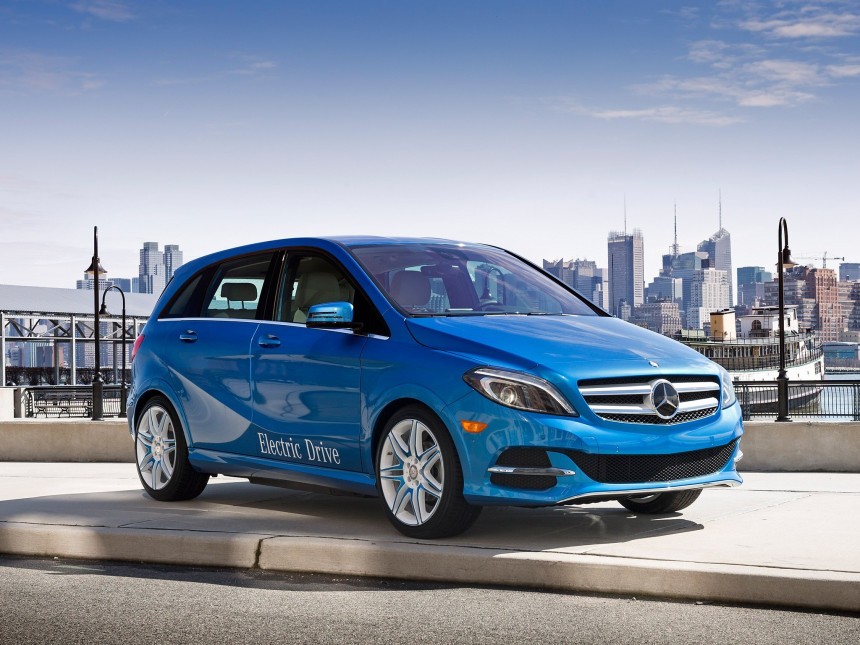
Photo: Mercedes-Benz
Sales in the US started in December 2013 as a 2014 model, although it was only offered in certain states that required ZEV mandates. The electric B-Class was rebranded in 2017 as the B250e following a change in Mercedes-Benz nomenclature. It wasn’t very successful, with only 4,100 units sold in the US by 2017, so it was discontinued.
I must say I was one of the first journalists to test drive the B-Class Electric Drive when it launched in Europe, and I kind of liked the car. Despite being slower than a typical gas-powered equivalent, it had a smoothness that every other ICE car lacks, including those wearing the three-pointed star. Although unsuccessful, the B250e paved the way for the more advanced electric models that followed.
Mercedes-Benz launches the EQ brand
The lackluster success of the B-Class Electric Drive prompted Mercedes-Benz to consider creating a dedicated electric brand to better differentiate its electric vehicles from the combustion models. The EQ brand was introduced at the Paris Motor Show in 2016 with the Generation EQ concept. The all-electric brand had ambitious plans to launch 10 EQ models by 2022 using an EV-dedicated modular platform.
Still, the first EQ electric models were based on ICE architectures shared with other Mercedes-Benz models. The first to launch was Mercedes-Benz EQC in 2019, sharing the mechanical bits with the GLC. The compact SUV is powered by two asynchronous electric motors, one on each axle, with a total power of 300 kW (402 horsepower). The 80-kWh battery allows it to drive up to 417 km WLTP, with an EPA estimate of 220 miles. You can charge it from 10 to 80% in 40 minutes using a 110-kW DC fast charger.
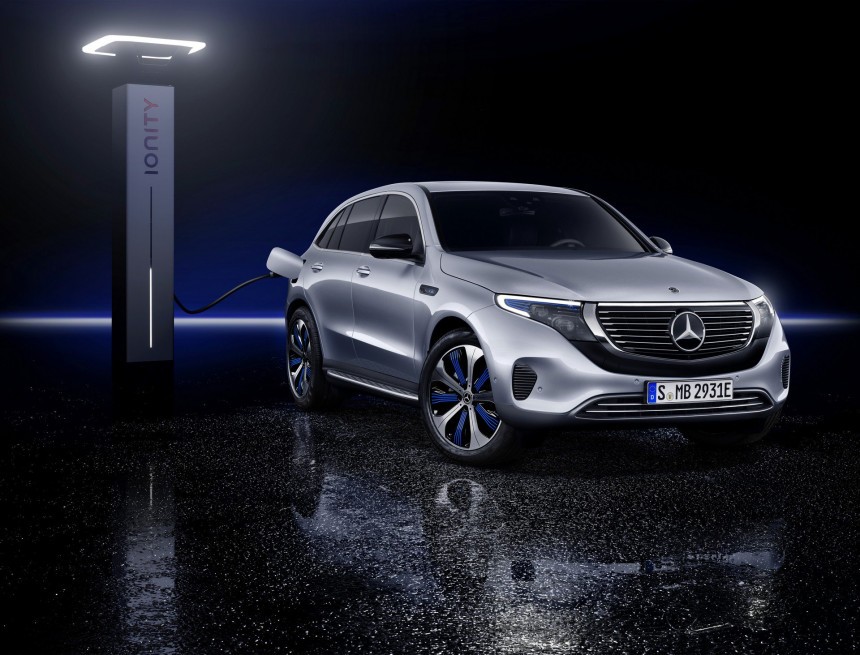
Photo: Mercedes-Benz
Mercedes-Benz backtracked on its plans to sell the EQC in the US, although the second generation of the model, planned for 2025, could change that. One year after the EQC, Mercedes-Benz also launched the EQV in Europe as an electric version of the V-Class. The luxury people mover was facelifted this year, but the German carmaker has no plans to offer it on the US market.
The smallest electric model in Mercedes-Benz’s lineup, the EQA, is only sold and produced in Europe and China. Launched in 2021, the subcompact luxury crossover shares the MFA2 architecture with the GLA. Although the latter is sold in the US, the EQA was deemed uncompetitive. The small electric crossover is available in Europe with front-wheel drive (EQA 250) and all-wheel drive variants (EQA 300, EQA 350). Power ranges between 190 horsepower and 292 horsepower, while the maximum range reaches 304 miles (490 km), albeit according to the WLTP standard.
Mercedes-Benz EQB
The EQB is the electric version of the Mercedes-Benz GLB and uses the same MFA2 platform as the GLA. It’s notably bigger, allowing it to offer seven seats in a three-row configuration, although five-seat layouts are also available. Similar to the EQA, the EQB is also available as EQB 250+ (one motor in front with 190 horsepower), EQB 300 (AWD, 225 horsepower), and EQB 350 (AWD, 288 horsepower).

Photo: Mercedes-Benz
Range-wise, the Mercedes-Benz EQB offers between 221 and 245 miles EPA estimates, decent numbers considering the 71-kWh battery. Performance is a little disappointing, especially considering that its electric rivals, including the Tesla Model Y, are much faster. The base EQB accelerates to 60 mph in 8 seconds, and the most powerful variant does the same in 6 seconds. The maximum speed is also limited to 100 mph (160 kph). By comparison, the slowest Tesla Model Y RWD needs 6.6 seconds to reach 60 mph and has a top speed of 135 mph (220 kph).
Despite these shortcomings, the Mercedes-Benz EQB costs more, with the 250+ variant starting at $52,750. Without benefitting from the IRA tax credit, the EQB appears significantly more expensive than the Model Y. Tesla SUV starts at $43,990 and costs less in the top Performance trim ($52,490) than the cheapest EQB while putting it to shame in range and performance departments. Some say that Mercedes build quality is enough to justify the price, but the sales numbers still show that Tesla Model Y is leading.
Mercedes-Benz EQS and Mercedes-AMG EQS
The Mercedes-Benz EQS was the first model built on the new dedicated EV platform promised in 2016. The technical details of the new Electric Vehicle Architecture (EVA) were announced in 2020, with the first models scheduled to launch in 2021. The Mercedes-Benz EQS was given the honor of bringing new features that were impossible using the old ICE platforms. The Mercedes-Benz EQS is also considered the brand’s first software-defined vehicle.
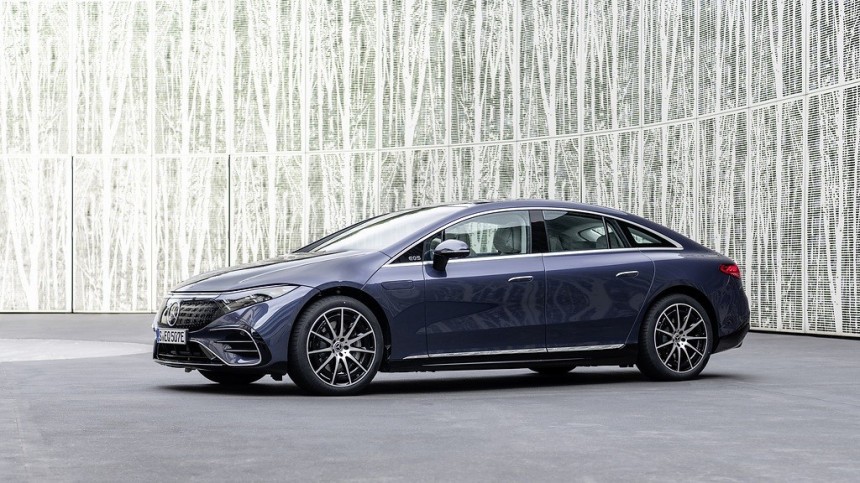
Photo: Mercedes-Benz
The electric equivalent of the Mercedes-Benz S-Class is as luxurious as you’d expect it to be while at the same time offering impressive specifications as an electric vehicle. Most notably, the aerodynamics stand out, with a drag coefficient of 0.2, the lowest on a production car when it was launched. The range is EPA-rated for 350 miles in the case of the RWD model, 340 miles for the AWD models, and 277 miles for the AMG 53.
The EQS is available in three flavors, including an AMG EQS sporty variant. Prices in the US start at an ambitious $104,400, with the AMG retailing for $147,550. The base version EQS 450+ relies on a 245-kW (329 horsepower) electric motor. This increases to 330 kW/440 horsepower for the dual-motor EQS 500 4Matic and 385 kW/516 horsepower for the EQS 580 4Matic. The AMG EQS 53 boasts up to 560 kW (751 horsepower) with boost, being powered from the same 108-kWh battery as the rest of the lineup.
Mercedes-Benz EQE and Mercedes-AMG EQE
The next model underpinning the EVA platform arrived a few months later as the electric equivalent of the E-Class. Sharing many parts with its bigger brother, it adopted the same four-door-coupe silhouette as the EQS. Normally, it offers less power, even when considering the same model number. For instance, the EQE 500 4Matic has 402 horsepower, whereas the EQS 500 4Matic boasts 443 horsepower. The battery pack is also smaller, at 90 kWh.

Photo: Mercedes-Benz
This affects its electrical range, with the most efficient variant, the EQE 350+, only reaching 305 miles on a charge. It’s all downhill from here, with the AWD variant going 260 miles while the AMG version stops after 225 miles. For a sedan that competes directly with the Tesla Model S, that’s utterly disappointing. The EQE prices start at $74,900, just below the Tesla executive sedan ($74,990). Still, Tesla has a 405-mile range and performance that puts even the AMG EQE variant to shame for $20K less.
The Mercedes-Benz EQE doesn’t stand out in the charging department either, considering it can only charge at up to 170 kW. This is lower than the 250 kWh of the Model S and 350 kW of the Genesis Electrified GV80. The EQE needs about 32 minutes to charge from 10% to 80%, compared to only 22 minutes in the case of Genesis.
Mercedes-Benz EQE SUV and EQS SUV
To round up the electric vehicle lineup based on the EVA platform, Mercedes-Benz also offered SUV variants of the EQE and EQS. These keep the essential characteristics of their correspondent models but provide more space and versatility. The downside is that the performance and range are penalized.
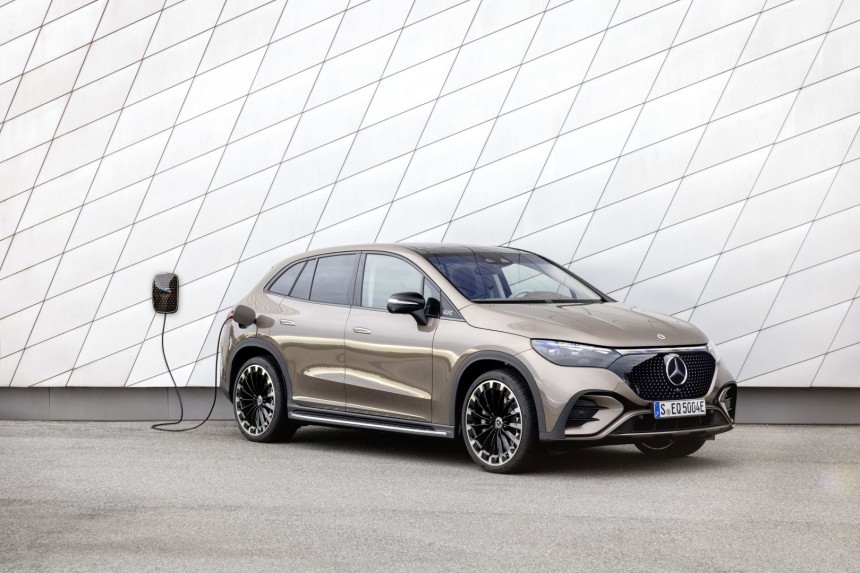
Photo: Mercedes-Benz
The Mercedes-Benz EQE SUV, for instance, needs 0.1 to 0.2 seconds more to reach 60 mph from a standstill, depending on the variant. It also loses up to 26 miles of range, although, strangely, the most powerful variants, the EQE 500 4Matic SUV and AMG EQE 53 SUV, gain about 10 miles. The EQE SUV is also more expensive, by $2,000-$3,000. The EQE 350 4Matic is the bizarre exception, as it costs $77,900 both as an SUV and a sedan.
The EQS SUV is at an even greater disadvantage, losing up to 55 miles of range compared to its sleeker brother. Mercedes-Benz thought to compensate, making the SUV a lot more attractive. For starters, regardless of the specifications, it has the same price as the sedan, trim for trim. Secondly, the EQS SUV is also available as a seven-seater, making it a compelling proposition.
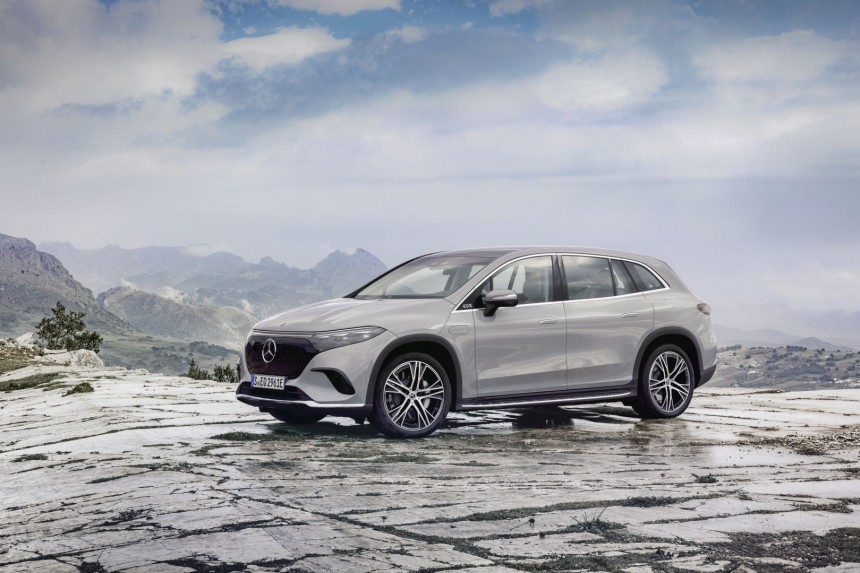
Photo: Mercedes-Benz
There’s a caveat, though, as the EQS SUV is not available as an AMG version. Instead, Mercedes plans to offer an ultra-luxurious Maybach variant. Although the pricing has not yet been communicated, expect it to be outrageous. The electric powertrain develops 649 horsepower, enough to propel it to 60 mph in 4.4 seconds. The EPA-estimated range tops at 280 miles, which is still respectable, considering all the features and luxury Mercedes-Benz crammed inside.
The future models, from top to bottom
As you can see, Mercedes-Benz already has most of the market segments covered, at least in its core markets. The US is catching up, especially as Mercedes-Benz expands its manufacturing footprint to benefit from the IRA incentives. The most anticipated electric model is the EQG, set to arrive next year on an electrified version of the second-generation G-Class platform.
Previewed by the Concept EQG at the IAA Mobility 2021 in Munich, the Mercedes-Benz EQG will be offered in two variants: the EQG 560 4Matic and EQG 580 4Matic. An AMG variant is also rumored, although no official confirmation exists. Expect the electrical parts to be sourced from the EQS SUV, including the 108-kWh battery. The most striking difference is that the EQG will likely be offered in a quad-motor configuration instead of the dual-motor EQS SUV.

Photo: Mercedes-Benz
As I’ve mentioned earlier, the second-generation EQC is also in the making and will arrive in the US sometime in 2025. Unlike the current generation, the upcoming model will be built on a dedicated EV architecture. It won’t be the EVA2 because this is reserved for the larger and more luxurious EVs. Instead, the next-generation EQC will use the upcoming Mercedes-Benz Modular Architecture (MMA), together with the future C-Class and other compact models.
One of them will be the electric variant of the CLA, as Mercedes-Benz will blur the lines between ICE and electric vehicles. As combustion engines will become obsolete, there’s little need for the EQ brand, especially as the MMA platform can also receive a combustion engine as a stop-gap solution. If you need a hint about the future model, Mercedes-Benz revealed the concept in Munich in September. I wouldn’t bet on the production model to be called CLA, though, since the four-door coupes are a dying breed. Instead, Mercedes-Benz will keep the design and specifications for the next-generation C-Class.

